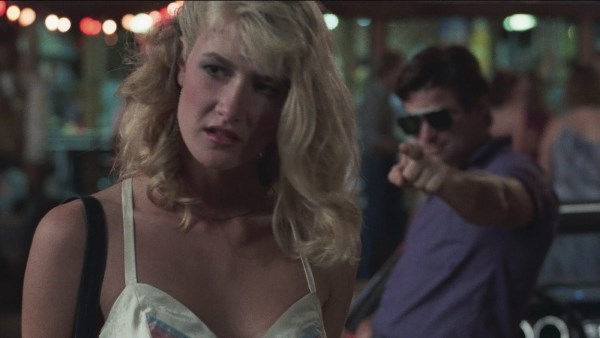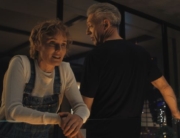
Actress Laura Dern won an Outstanding Supporting Actress Emmy in 2017 for Big Little Lies and the Best Supporting Actress Academy Award for Noah Baumbach’s Marriage Story back in February. It’s now October, and she’s still having a moment. Last year, she appeared in person at the New York Film Festival promoting her soon-to-be Oscar-winning role. She returned to the festival this year (in its online form, that is) with her very first lead role: Joyce Chopra’s Smooth Talk (1985), which screened in the NYFF’s Revivals section.
At 17, Dern made the discomforting and candid coming of ager shortly after her brief role in the cheesefest Grizzly II: Revenge (1983), in which she shared scenes alongside Charlie Sheen and George Clooney. Spoiler alert: she, Sheen, and Clooney, whom she canoodles with in a sleeping bag, don’t have much screen time: Mama Bear is quite angry. Made in Hungary, the film has only recently been completed, and is an odd patchwork of poorly acted scares spliced together with a pop concert—don’t ask. The B movie is a reminder of the sort of work that often lies at the bottom of an actor’s resume, and based on Dern’s brief screen—or scream—time here, there’s no indication that she could credibly take on a complicated lead role a short time later.
By comparison, Smooth Talk is a huge leap in terms of filmmaking and acting. Its depiction of teenage rebellion and sexuality is a prescient forerunner for a genre that Wired senior writer Kate Knibbs has called “the troubled girl canon,” for movies dealing with “burgeoning teen girl sexuality.” This celluloid sorority has been a prolific staple for French filmmakers—Céline Sciamma’s Water Lilies and Rebecca Zlotowski’s recent An Easy Girl. Knibbs mentions Catherine Hardwicke’s Thirteen and Andrea Arnold’s Fish Tank as English-language examples.
Chopra and Tom Cole’s screenplay, based on Joyce Carol Oates’s 1966 short story “Where Are You Going, Where Have You Been?” is frank, though not blunt or gratuitous. The result is not nearly as dark as the source material, and it has a completely different ending in keeping with its realistic tone, whereas Oates’s conclusion leans more toward the metaphorical.
Chopra’s film is a fascinating time capsule, very much of a bygone era when suburban teens flocked to the mall rat scene. (The synthesizer-based score hasn’t aged well, though.) During the summer before her sophomore year, high schooler Connie (Dern) routinely ditches her long-complaining mom, Katherine (Mary Kay Place), who needs help painting the family’s fixer-upper. The willowy blond teen instead spends her afternoons with her two sidekicks at the mall. There she stashes away the baggy jersey she wore at home for more provocative attire and basks in the attention from guys.
In one outing, she convinces her friends to hang out at a popular roadside dinner, and here, among an older crowd, Dern wears Connie’s awkward and gangly physicality like an off-the-shoulder sweatshirt. This is especially noticeable when Connie alternatively flaunts and obscures her body as she leans over a counter, half-heartedly attempting to hide her halter top. That’s the night when she’s first noticed by 30ish Arnold Friend (Treat Williams)—or at least that’s the name he goes by—dressed in the James Dean uniform of a tucked-in T–Shirt, Levi’s jeans, and pilot Ray-Bans.
As a performer, Dern’s at her most self-conscious when Connie grabs the center of attention—and hams it up, obnoxiously so. Together with her friends, the trio raise the decibel level considerably, ignoring the stares of the quickly parting and annoyed older shoppers. Dern’s unquestionably at her best in the taut 30-minute climactic confrontation with Williams. Viewers can trace Connie’s openness, caution, and fear all through her body language.
Although driven by Dern, the film’s essentially an ensemble piece. Williams’s cock of the walk is on the surface a charmer with confidence to spare, which makes him more sinister when Arnold arrives at Connie’s home, knowing she’s alone. (To get a sense of how much darker the short story is, Oates based Arnold on a real-life serial killer.) Place and Elizabeth Berridge, as the older sister Connie considers a buzz-kill frump, are also terrific.
Chopra and co-writer Cole have greatly expanded the 16-page short story by creating from scratch the film’s central relationship, between Connie and her mother. Oates has said that one of her themes is the failure of communication, that parents live in their own world apart from their children. In a significant broadening of the story line, the movie’s mom reaches out, confessing to Connie that she wants the close relationship they once had, but Katherine can’t help but bristle when she notices that Connie has styled her hair differently. She has a good idea of what her daughter is experiencing, yet she can’t restrain herself from losing patience and resisting the emerging identity that Connie’s carving out for herself.
Mother and daughter read each other too well. All it takes is a look or a smirk to set one off. Maybe what the film accomplishes best is detailing the layered and mercurial relationship between the three women in the family, all of whom love and support each other when they’re not at each other’s throats.
And in case you miss its streaming window during the festival, Janus Films’ restoration of Smooth Talk will return on November 6 at the Film at Lincoln Center’s Virtual Cinema.






Leave A Comment